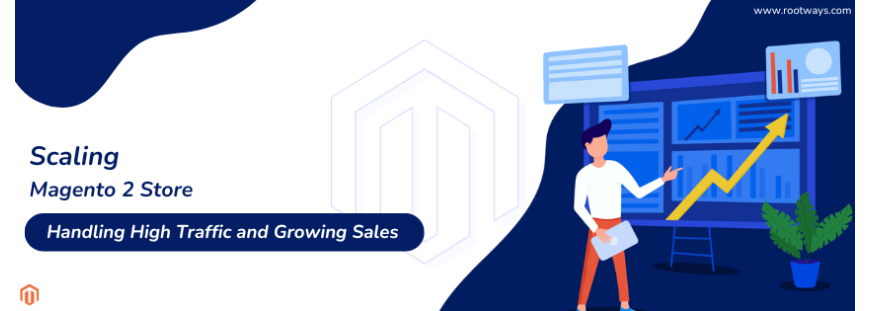
Scaling your Magento 2 store: handling high Traffic and growing sales
In the dynamic world of online retail, growing your Magento 2 store involves more than just handling heavy Traffic. It also entails encouraging sales development. It's critical to ensure your website can accommodate growing loads while giving clients a flawless online purchasing experience as your business grows. Here's a quick method to scaling your Magento 2 store efficiently.
- Optimize Performance:
Ensure your Magento 2 store is operating at peak efficiency before scaling up. This includes optimizing code and database queries, utilizing caching techniques, and fine-tuning server setups. In addition to enhancing user experience, a website that loads quickly is ranked higher in search results.
- Pick the correct Hosting Solution:
Go with a hosting company with scalability options that meet the needs of Magento 2. Think about dedicated servers or cloud hosting options that let you modify resources in response to variations in Traffic. Make sure that the PHP and MySQL configurations on the hosting environment are optimized for the hosting environment and optimized for the unique requirements of Magento 2.
- Put material Delivery Networks (CDNs) into Practice:
CDNs distribute website material among numerous servers worldwide, lowering latency and speeding up page loads, particularly for consumers who are situated far from your servers. Use a CDN with your Magento 2 store for more effective delivery of static material like photos, CSS, and JavaScript files.
- Upgrading Hardware and Infrastructure:
As your Magento 2 store expands, ensure it can handle the additional traffic and data processing needs by routinely assessing and upgrading its hardware and infrastructure. Invest in reliable networking hardware, storage systems, and servers to enable scalability without sacrificing efficiency.
- Make use of Scalable Architecture:
Scalability should be considered when designing your Magento 2 store. Provide a modular architecture that simplifies adding extra servers or instances as needed, enabling easy horizontal scaling. Employ technologies such as auto-scaling groups and load balancers to dynamically alter resources in response to demand and evenly distribute Traffic among several servers.
- Monitor Performance and scalability:
Using analytics and monitoring tools, keep an eye on the performance and scalability metrics of your Magento 2 store. Monitor essential metrics, including resource usage, traffic trends, website uptime, and server response times. Determine areas for improvement and bottlenecks to tackle scalability issues in advance.
- Optimize for Mobile and Omnichannel:
Optimizing your Magento 2 store for mobile devices ensures compatibility with a range of channels and devices. This is important due to the growing popularity of omnichannel shopping experiences and mobile commerce. Adhere to responsive design guidelines, expedite checkout procedures, and provide frictionless interaction with social media and mobile applications.
To optimize Magento scalability, consider the following strategies:
- Turn on Flat DirectoriesMagento has a particular method of storing data, and turning on flat directories can improve Performance.
- Scale-up increases a server's capacity to host your Magento website by adding more hardware, including RAM, storage, or processing power. This method has limited capacity and can be expensive.
- Scale Out: increasing the number of servers to manage erratic spikes in demand. By distributing user requests among the servers, a load balancer may guarantee high availability for your Magento website.
- Manual scaling: Modify the server’s resources by hand as necessary. Because this method is reactive and time-consuming, adjusting to minute-by-minute changes in Traffic is challenging.
- Use Magento's additional caching technologies, such as block caching, database query caching, and full-page caching, to lower server load and speed up response times.
- Optimise Images and Media: To minimize file size without sacrificing quality, compress images and media assets. This enhances website load times and lowers bandwidth consumption.
- Employ Elasticsearch: Elasticsearch can be used to enhance the scalability and Performance of catalog search, particularly for sizable product catalogs.
- Turn on Flat Catalog: Turn on Magento's Flat Catalog function to minimize the number of database joins needed to retrieve product information, thereby increasing Performance.
Conclusion:
You can use these tactics to scale efficiently to manage heavy Traffic and support long-term sales growth for your Magento 2 store. Scalability is a continuous process that needs regular monitoring, optimization, and adjustment to meet changing customer demands and corporate requirements.
CONTACT US; We are always prepared to provide prompt assistance and support.